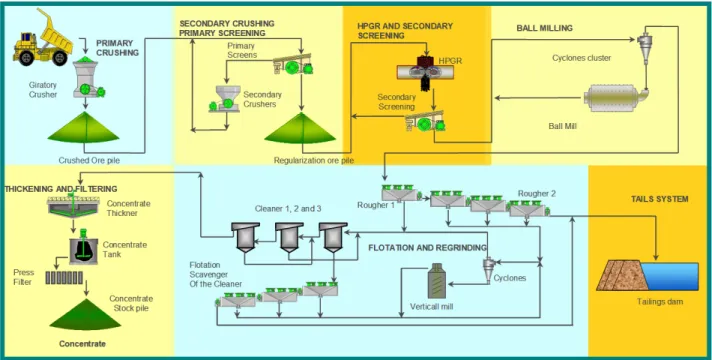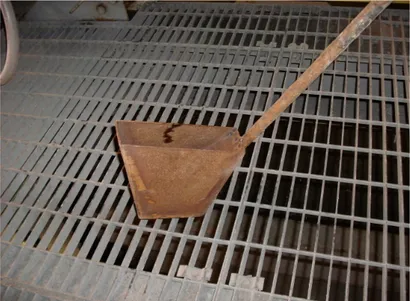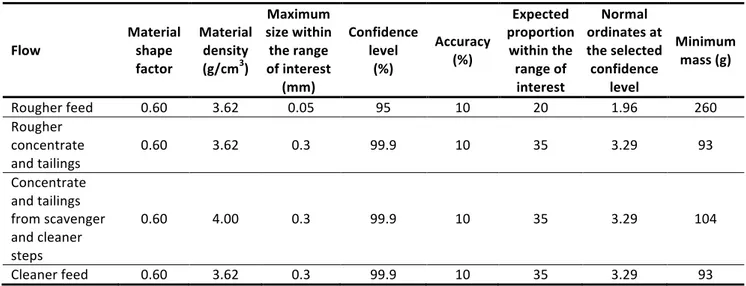AVALIAÇÃO DA GRANULOMETRIA DE ALIMENTAÇÃO E DOS PRODUTOS DA ETAPA
ROUGHER DE FLOTAÇÃO DA USINA DO SALOBO DE BENEFICIAMENTO DE
MINÉRIO DE COBRE SULFETADO
R. A. FONSECA1, F. C.F. OLEGARIO JÚNIOR1, M.G. BERGERMAN2*
1Vale S.A., Salobo Mine, 2University of São Paulo’s Department of Oil and Mining Engineering
mbergerman@usp.br* Submitted 09/11/2017 – Accepted 15/11/2017 DOI: 10.15628/holos.2017.6524 RESUMO
A usina do Salobo processa um minério sulfetado de cobre e ouro. A etapa de flotação compreende estágios
rougher, cleaner e scavenger do cleaner, sendo que os
concentrados das etapas rougher e scavenger do cleaner passam por um estágio de remoagem antes de seguir para a etapa cleaner. Ao longo dos primeiros anos de operação, observou-‐se que a granulometria de alimentação da remoagem estava consistentemente mais fina que o esperado, mesmo considerando-‐se que
a granulometria de alimentação da flotação (etapa
rougher) estava dentro dos parâmetros esperados e
significativamente mais grossa que o concentrado
rougher. Este trabalho apresenta os resultados de
ensaios laboratoriais e das amostragens de campo para identificar a origem de tal diferença e quantificar a mesma, assim como ilustra os impactos na etapa de remoagem do concentrado cleaner.
PALAVRAS-‐CHAVE: Flotação, Remoagem, Cobre, Classificação.
EVALUATION OF THE ROUGHER FEED AND CONCENTRATE SIZE DISTRIBUTIONS
FROM THE SALOBO SULPHIDE COPPER ORE PROCESSING PLANT
ABSTRACT
Salobo plant processes a gold and copper sulfide ore. The flotation process comprises the rougher, cleaner, and scavenger stages. Concentrate from the rougher and scavenger stages goes through a regrinding process before being fed into the cleaner stage. During the first years of operation, it was noticed that the regrinding feed size was consistently finer than expected, even though the flotation feed size (rougher
stage) was within the planned parameters and significantly coarser than the concentrate from the rougher stage. This paper describes the results of field samplings and laboratory tests carried out to identify the factors behind such difference and to quantify it. Moreover, it shows the impacts of such size difference on the concentrate regrinding stage.
KEYWORDS: Flotation, Regrinding, Copper, Classification.
1 INTRODUCTION
Vale’s Salobo mine, located in Marabá, state of Pará, started operation in 2012. Reserves are estimated at 1.2 billion tons with copper and gold contents of 0.76% and 0.56 g/ton, respectively (for a 0.3% copper equivalent cut off) (Vale, 2016).
The copper ore is essentially calcitic, with a minor proportion of bornite and chalcopyrite. The Salobo plant processes 78,000 tons/day of copper ore and its rated production capacity is higher than 470,000 tons/year of copper concentrate. Figure 1 shows the process flowsheet.
Figure 1: Salobo process flowsheet (ROSA et al., 2007)
The Salobo plant circuit is described in detail by Godoy et al. (2010) and Rosa & Rodrigues (2013). Core subject of this paper, the Salobo flotation circuit is briefly described below. With a P80 around 106 µm, the overflow from the ball mill cyclones goes through the flotation rougher
stage. Two cyclone batteries are fed with concentrate from the flotation rougher and scavenger stages through variable speed pumps. The cyclone overflow is fed by gravity into vertical mills. Two vertical mills operate in a closed circuit along with the cyclone system. The vertical mill output is fed into classifying cyclones. With a P80 around 24 µm, the regrinding output (cyclone
overflow) undergoes flotation in cleaner columns. The cleaner concentrate is the final product, while the cleaner tailings are fed into the scavenger stage.
A monthly sampling routine was set up to assess the flotation performance of the whole flotation circuit at Carajás copper mills (Sossego and Salobo). The collected samples were submitted to chemical analysis and grain size distribution determination. The study results enabled the process team to optimize this circuit stage. Data were reviewed in terms of the grain size distribution behavior along the flotation circuit (Bergerman, 2013), which unveiled significant grain size differences between the rougher feed and the concentrate output from the rougher
(2016). The grain size difference between the rougher feed and the rougher concentrate was demonstrated. Although the Salobo and Sossego Projects’ process routes have been extensively studied, such difference had not been foreseen in the design stage, as the expected grain size of the rougher concentrate to be fed into the vertical mill was established as the same grain size of the rougher feed. This paper aims to quantify such difference and assess its impact on the flotation and regrinding processes at Salobo mill.
2 MATERIALS AND METHODS
For the purpose of circuit diagnostic, samples were taken from the following points at Salobo mill:
-‐ Overflow from the ball mill cyclones (rougher feed) -‐ Rougher concentrate;
-‐ Rougher tailings; -‐ Cleaner feed;
-‐ Cleaner concentrate;
-‐ Cleaner tailings (cleaner scavenger feed) -‐ Cleaner scavenger concentrate;
-‐ Cleaner scavenger tailings;
-‐ Final tailings (pipeline that conveys both the rougher tailings and the cleaner scavenger tailings).
Figure 2 shows the sampler used to collect samples from the cyclones and Table 1 illustrates the factors used in the calculation of minimum mass to be collected from each flow.
Figure 2: Sampler used to collect samples from the cyclones
Table 1: Minimum mass calculation based on the formula proposed by Gy (1992).
Flow Material shape factor Material density (g/cm3) Maximum size within the range of interest (mm) Confidence level (%) Accuracy (%) Expected proportion within the range of interest Normal ordinates at the selected confidence level Minimum mass (g) Rougher feed 0.60 3.62 0.05 95 10 20 1.96 260 Rougher concentrate and tailings 0.60 3.62 0.3 99.9 10 35 3.29 93 Concentrate and tailings from scavenger and cleaner steps 0.60 4.00 0.3 99.9 10 35 3.29 104 Cleaner feed 0.60 3.62 0.3 99.9 10 35 3.29 93
Samples were always taken over a two-‐hour period, when the mill operation was deemed stable, with sample increments taken every 15 minutes. An important aspect taken into consideration during sampling was the well pump status, as they could make the circuit unstable when they are in operation. In this study, such pumps were switched off two hours prior to sampling.
The samples were sent to the Salobo mill’s process laboratory. Initially, solids percentages were determined for all samples, followed by wet screening with the following sieve meshes: 425, 212, 150, 106, 75, 45, and 38 µm. The product retained in each mesh was submitted to chemical analysis at the Salobo mill’s chemical laboratory, where the copper content was determined by means of atomic absorption.
This study comprised seven sampling campaigns, which were carried out in 2015 and 2017.
Moreover, laboratory tests were conducted to simulate the rougher stage using the same feed as that used in the industrial plant. The aim was to assess whether the grain size segregation is the same in both industrial and laboratory scale.
3 RESULTS AND DISCUSSION
Samples taken from the industrial circuit provided grain size data relative to the rougher feed, which were compared to the grain size data for the rougher concentrate, which is the new feed material for the regrinding circuit. Figure 3 illustrates such data.
Figure 3: P80 of the rougher feed and concentrate
Figure 3 data illustrate a clear trend toward significantly finer rougher concentrate when compared to the rougher feed. Such difference is possibly due to two factors. First, coarser particles might not have been released or are too heavy to be floated, in which case they become part of the tailings. The second reason is that sulfides existing in the Salobo ore and that are concentrated in the rougher stage have a significantly higher density than the rest of the gangue, which consists mainly of oxides and silicates. Such difference in density probably leads sulfide particles of the same size as gangue particles to be transferred to the ball mill cyclone underflow, in which case they are overground. This has a major positive impact on the operation of Salobo’s vertical mills, as the grain size of the feed material is approximately 50% finer than the design grain size.
To assess the impact of the difference between feed and concentrate grain sizes on the rougher recovery, the recovery rate was determined for each grain size range for all samplings. Table 2 shows the average results for each sampling.
Tabela 2: Metalurgical recovery for each grain size – average results for sampling from 2008 to 2011 Mesh (µm) Metallurgical copper recovery (%) Copper partition by fraction (%)
212 3.60 1.49 150 25.05 5.15 106 54.29 8.82 75 68.89 12.37 45 80.03 14.67 38 86.85 11.30 <38 87.80 46.20 Stage average 77.97 100
It can be seen that there was a significant decline in the copper recovery rate for the coarser fractions. Such lower recovery does not have a significant impact on the average recovery of this flotation stage, as the amount of copper in the coarser fractions is very low (approximately 10%), as shown in Table 2. For the sake of information, the rougher stage represents 75% to 85% of the mill’s final tailings, according to results from samplings carried out for this study.
The behavior observed in the rougher stage was not found in the cleaner and cleaner scavenger stages – the feed and concentrate have similar grain size distributions.
The laboratory test results point to the same trend observed in industrial scale – the rougher concentrate is significantly finer than the feed, as Table 3 illustrates.
Table 3 – Laboratory test results
P80 (mm)
Sampling 6 Sampling 7 Rougher 1 concentrate 0.044 0.060 Rougher 2 concentrate 0.069 0.045 Average rougher concentrate 0.057 0.053 Rougher tailings 0.114 0.100
4 CONCLUSIONS
This study provided evidence that there is a significant difference between the feed and concentrate grain size distribution in the flotation process rougher stage at Salobo mill, which is similar to the situation found in a previous study at Sossego mill. A significant percentage of the coarser portion is segregated directly as tailings in this stage. Such situation does not have a major impact on the metallurgical recovery of the process, because the coarser fractions contain just around 10% of the copper contained in the flotation feed. However, there is a significant positive effect on the operation of the vertical mills, as their feed is much finer than the design grain size. This characteristic may be found in other mills processing sulfide ores and it should be taken into account when designing vertical mills.
5 ACKNOWLEDGMENT
The authors wish to thank Vale S.A. for the authorization to publish this paper. They also like to thanks Fapesp research project 2015/11739-‐2 for the financial support for this project.
6 REFERENCES
Bergerman, M. G. (2009). Modelagem e simulação do circuito de moagem do Sossego Dissertação de mestrado. Universidade de São Paulo, São Paulo, Brasil.
Bergerman M. G. (2013). Dimensionamento e simulação de moinhos verticais. Tese de doutorado. Universidade de São Paulo, São Paulo, Brasil.
Godoy, M. L. S., Bergerman, M. G., Godoy, P. H., & Rosa, M. A. N. (2010). Development of the Salobo Project. 2010 CIM Conference and Exhibition Proceedings. Vancouver, Canada.
Gy, P. M. (1992). Sampling of heterogeneous and dynamic material systems: theories of heterogeneity, sampling and homogenizing. Amsterdan: Elsevier.
flotação da usina do Sossego. HOLOS, 7, 88-‐93, Dec. 2015. Available at: http://dx.doi.org/10.15628/holos.2015.3655
Rosa, M. A. N., Bergerman, M. G., Miranda, A., Oliveira, J. L., Souza, M., Batista Filho, J., & Cardoso, W. (2007). Controle operacional da usina do Sossego. VII Meeting of the southern hemisphere on mineral technology e XXII Encontro nacional de tratamento de minérios e metalurgia extrativa. Ouro Preto, Brasil.
Rosa, M. A. N., & Rodrigues, W. J. (2013). Flotação de cobre em Sossego e Salobo. In: Pinto Chaves, A. (Org.), Teoria e prática do Tratamento de Minérios, volume 4 -‐ A flotação no Brasil. 3ª ed. São Paulo: Oficina de Textos.
Vale (2016) Form 20-‐F Annual report pursuant to section 13 or 15(d) of the Securities Exchange Act of 1934 for the fiscal year ended: December 31, 2016, commission file number: 001-‐15030.
Disponível em: http://www.vale.com/EN/investors/information-‐market/annual-‐
reports/20f/20FDocs/Vale_20-‐F_FY2016_-‐_i.pdf




